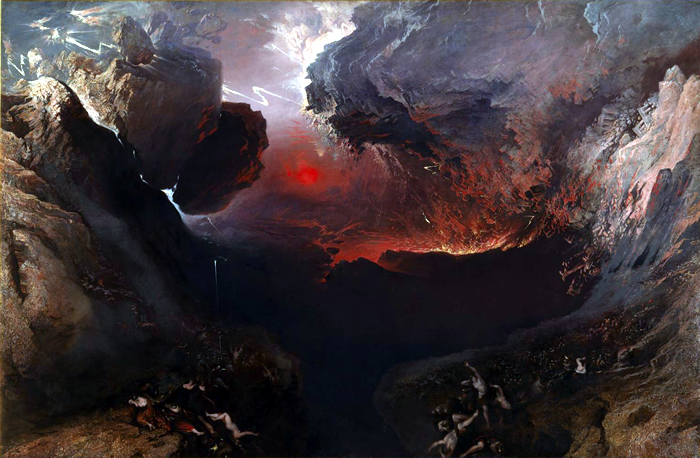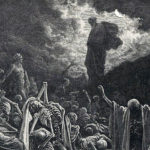Good Friday and Revelation’s Judgment on Sin
I just released a new supernatural conspiracy novel about the historical origin of the book of Revelation titled, Tyrant: Rise of the Beast, which drew me into the eternal debate over Bible prophecy interpretation. I want to share a little something of the power and beauty of Biblical imagination that I have learned in the process.
If we want to approach Revelation properly, we must understand that its interpretation is rooted in an ancient Jewish context of meaning, not our modern one. We must seek to understand the text as its original writer intended. And that context is saturated in the imagery of Old Testament prophecy.
The apostle John draws so heavily from the Old Testament that scholars claim it has more Old Testament allusions and echoes than any other New Testament book. If we want to “unveil” the hidden beauty and meaning of God’s Word (revelation means unveiling), we must look back to the Old Testament first, before we start exegeting current newspapers looking for modern correspondences. And when you do look back instead of forward, wow, what an unveiling of Jesus Christ occurs!
One of the primary purposes of Revelation, stated right up front by John, is to describe God’s judgment on those who pierced Christ.
Behold, he is coming with the clouds, and every eye will see him, even those who pierced him, and all tribes of the land will wail on account of him.1
This is particularly relevant for Good Friday meditation because it gives the believer hope that Christ will be vindicated against those who rejected him as messiah and crucified him. There is judgment on sin before resurrection and final glory.
But what does this judgment look like? Many Christians read Revelation so literally as to assume that this involves the physical destruction of the world. They read passages like the sixth seal and it seems so obvious:
When he opened the sixth seal, I looked, and behold, there was a great earthquake, and the sun became black as sackcloth, the full moon became like blood, and the stars of the sky fell to the earth as the fig tree sheds its winter fruit when shaken by a gale. The sky vanished like a scroll that is being rolled up, and every mountain and island was removed from its place.2
To our modern non-Hebrew eyes this reads like scientific cosmic catastrophes. Meteorites pounding the earth, the sky being sucked into a black hole, and all the mountains flattened and all the islands gone.
And Jesus seems to affirm this when, at his Olivet Discourse, he says that “Immediately after the tribulation of those days the sun will be darkened, and the moon will not give its light, and the stars will fall from heaven, and the powers of the heavens will be shaken.”3
To us, this all reads like the end of the space-time universe. Except it’s not.
John’s language is nothing new to his ancient Jewish audience. They were very familiar with this kind of imagery from the Old Testament prophets who used extreme cosmic catastrophes all the time as spiritual metaphors to describe the fall of earthly rulers and the spiritual principalities and powers behind them.
In fact, in this very passage of Revelation 6, John draws directly from Isaiah. The prophet describes the fall of Edom and the surrounding nations to the Babylonians around 587 BC with the same exact terms as does John.
All the host of heaven shall rot away, and the skies roll up like a scroll. All their host shall fall, as leaves fall from the vine, like leaves falling from the fig tree. For my sword has drunk its fill in the heavens; behold, it descends for judgment upon Edom, upon the people I have devoted to destruction.4
But here’s the point: this all happened in 587 BC. You read that right.
When the Babylonians destroyed Edom, the stars obviously didn’t literally fall to the earth. Remember, if you believe this is literal, then you would have to believe that literal stars fell to our literal earth. But stars are suns like our own. One star/sun alone would have burned up the entire galaxy on its way to collision with earth. So no one takes that literally (meteors would be a non-literal interpretation). The sky didn’t literally roll up like a scroll (or black hole) in 587 BC, because if it did, it would have been the end of the space-time universe.
Isaiah is describing the fall of earthly rulers and their spiritual powers behind them. He says so in Isaiah 34:12: “[Edom’s] nobles—there is no one there to call it a kingdom, and all its princes shall be nothing.”
In the Bible, the sun, moon and stars (“heavenly host”) were symbolic of earthly rulers and their spiritual powers behind them (Judg 5:19-20). When God destroyed Babylon through the Medes in 539 BC, he described it as the “destruction of the whole earth” (Isa 13:5), the “darkening of the sun, moon and stars” (v. 10), and the earth and heavens being “shaken from their place” (v. 11). Obviously, the whole earth wasn’t destroyed in 539 BC, nor were the earth and heavens shaken from their place, otherwise, none of us would be here. This same exact language that John uses in Revelation is not end of the space-time world, but a spiritual metaphor for the fall of earthly and heavenly powers under the judgment of God (Isa 24:21).5
So it is true that God is judging in Revelation, but it is not necessarily the literal destruction of the heavenly host and earth that is occurring, but a judgment of God upon the earthly rulers and spiritual authorities behind them.
And think about it. In Christ’s death, he “disarmed the rulers and authorities and put them to open shame, by triumphing over them in him” (Col 2:15). Christ’s triumphal parade did not occur until his resurrection and ascension into heaven (1Pet 3:22; Eph 4:8-9), but his victory over the principalities and powers in both heaven and earth was accomplished first and spiritually at the cross. Christ’s sacrifice of the New Covenant was a spiritually real but physically metaphorical “shaking of the heavens and earth” (Heb 12:22-28).
Of course, this is only the tip of the holy mountain of biblical symbolism used by John in the book of Revelation. If you want to dive into more exploration of this ancient Hebrew worldview, I’ve written a companion book for the novel. It’s called End Times Bible Prophecy: It’s Not What They Told You.
Check out the novel Tyrant: Rise of the Beast here.
In part 2, available Saturday, April 15, Brian Godawa shares an Easter exploration of God’s earth-shattering New Covenant.
- Revelation 1:7. ↩
- Revelation 6: 12-14. ↩
- Matthew 24:29. ↩
- Isaiah 34: 4-5. ↩
- When God judged Israel in 586 BC through the Babylonians, Isaiah describes that event as the foundations of the earth “trembling” (Isa 24:18), the earth being “split apart,” “violently shaken,” “staggering,” and falling, “not to rise again” (v. 19-20), as well as the sun and moon being “confounded and ashamed” (v. 23). He then explains to us that these cosmic disturbances were not the literal end of the universe that they read like, but metaphors for the fact that God “will punish the host of heaven, in heaven, and the kings of the earth, on the earth” (v. 21). ↩









































Overall a solid and informative post, Brian. I did do a double take on this line, though:
“One star/sun alone would have burned up the entire galaxy on its way to collision with earth.”
That’s a page from the JJ Abrams school of astronomy there. 🙂 Despite what his Star Trek movie showed us, changes to a single star, while dramatic and cataclysmic for the star systems involved, would not be of the magnitude to burn up, or even significantly change, the galaxy.
We have evidence that stars explode (supernova) regularly. There are certainly some effects in terms of radiation surges–like the surge of light in the visible spectrum that we can see–that will be observable to other star systems in the galaxy, but the further the system is from the supernova, the less the effect.
In fact, because of the vastness of space between stars, I’m betting that if you were to drag a star across the galaxy to meet our sun, most systems wouldn’t even notice, except for the moving light. Our solar system would be altered (and whatever system belonged to the star) by the collision…but elsewhere it would be a galactic “meh”.
Kerry, Maybe we’re thinking about two different things. Not sure I understand your point. A bunch of stars (similar to the size of our sun) “falling to earth” is quite literally impossible. I mean, if one tries to interpret “literally,” the text is not talking about meteorites (that would be figurative). I was trying to show the absurdity of literal stars/suns falling to earth. Imagine a hundred stars the size of the sun “falling to earth.” in keeping with the so-called literalism attempt, the text doesn’t say “stars exploding,” but “falling to the earth.”
I was critiquing the line I quoted, Brian. One star wouldn’t burn up the galaxy on its way to Earth. The astonomy of that line is in error. And it is the type of error JJ Abrams frequently makes in his movies.
Oh, I think I see where the misunderstanding is. I used the word galaxy to mean the planets all burning up as a second sun collides with them on it’s way toward burning up the earth once it got close enough to do so. Sorry for my scientifically imprecise Biblical language 🙂 I didn’t mean the vacuum of space burning up. Of course, many stars falling to earth would be a stellar collision of multiple stars that would most likely result in a backhole forming which would then suck in everything in our galaxy.
I am not in agreement with this post on several levels. I would not have commented, but I mentioned something on Facebook with E. Stephen Burnett, in which he asked me to share my thoughts here. In short, this post uses an Old Testament prophetic destruction of places that the literalists would say have echoes to, or foreshadowing of, a future destruction that will happen litteraly and offers this as proof that astronomical references in Revelation should be taken as mere symbols. I’m not buying this line of thought has proven anything, but let’s run with the idea.
Have you met any Edomites lately? They are all totally gone, right? Though the history of their disappearance from the world stage is more complex than just the actions of the Babylonians in 587 B.C., they are in fact totally gone, as per the prophecy. So when Revelation talks about destruction of the world and the establishment of a new, direct rule of God, are we then supposed to imagine that such a prophetic destruction is not going to happen because it did not happen to the Edomites?…WOOPS…it actually did happen to them! So even this post’s view actually supports a concept of symbols with literal meaning–as opposed to symbology alone, with only spiritual lessons to learn.
When the Babylonians are said to bite the dust…yeah, they are gone, too. Yes, it would seem that the language may be partially spiritual in some prophetic references, partially hyperbolic perhaps. But these Old Testament prophecies cited get LITERAL fulfillments, at least at times.
So that would mean that Revelation DOES predict an end of the world, because it addresses the entire world in clear contrast to the heavenly powers. It predicts that physical destruction even by the method of looking at Old Testament symbols mentioned here, though it does not necessarily promise the means to be what we would expect from a literal prophetic reading. So I don’t think these views are really that pertinent to the question as to whether or not Revelation has literal meaning for the future of the world. If the book has ANY meaning at all for the future, there are certain things it can be said to say. The views in this post are not enough to equate Revelation as symbols-and-nothing-but-symbols. (Though that may not be the actual position expressed here either, to be fair. I’m not sure.)
As to the pertinent question of stars, note the Greek word “aster” used in Revelation would be better translated as “astronomical body.” Planets are called “asteres planetes” (wandering *stars* er, astronomical bodies), comets are called “asteres cometes” (bearded “***” stars), and meteorites, while described by a separate word for anything atmospheric, including wind (“meteoros”), they could also be described, as they are today sometimes, as shooting or streaking “stars.” In other words, it is not in fact impossible for a third of the visible astronomical bodies at a particular time to literally fall to Earth in the form of comet or asteroid fragments. Parts of Revelation in which it talks about things like “a burning mountain falling into the sea” (8:8) sound very much like astronomical bodies falling from space–and some of that language has no parallels in the Old Testament…FYI.
Travis,
Thanks for taking the time to give your feedback and comments.
I don’t believe symbols in the book of Revelation or the OT are “mere symbols” at all. I think this is one of the common misunderstandings that come from “literalism.” All symbols have real world or historical referents. Daniel’s and Revelation’s Beasts are symbols of monstrous evil governments, but they are symbols. There is no need to fear symbolism. In fact, John said that the angel “signified” or made known by way of symbolism (That is what the Greek of Revelation 1:1 literally says).
And in a way, you made my point for me. You describe the ultimate utter devastation of Edom. And that was my point. The utter devastation of cities or nations or peoples in the OT is often described as being so spiritually significant that the prophets describe it using the language of a collapsing universe, which of course did not happen physically or “literally.” Yes, there was massive physical destruction of Edom and the fall of her rulers on earth as well as heaven. That’s all real historical stuff that is poetically described as if the sky was falling. I am not sure how you concluded that I was saying this was “symbology alone” with “only spiritual lessons to learn” I really didn’t say that at all.
Do you believe that God “destroyed the whole earth” when he judged Babylon? (Isa 13:5) That is what the text literally says. But the text literarily means that when God judged the rule of the known world, it was like destroying the whole earth spiritually speaking. It involved real world destruction, but not of the whole earth.
Do you believe that the entire earth was returned to the “formlessness and void” of Genesis 1 when God destroyed the first temple in 587 BC? Because that is what the text literally says in Jeremiah 4:23-30. What the text literarily means is that destroying the physical covenantal system of God (the temple) was the spiritual equivalent of the world returning to chaos without God.
I think you would agree that the Bible uses both symbols and historical referents mixed into its prophecies. The problem is discerning which is which. No one is saying it is easy. But we must be careful not to impose our own theological bias before we seek to understand the text through the eyes of the original writers and readers.
And when you see a pattern of multiple uses of language in the OT of the destruction of cities, peoples or nations using a collapsing universe, and in fact, the universe did not collapse, then it is clear that this is a common way that Hebrews wrote about such things. Collapsing universe was regularly used as a symbol of history changing or world changing events.
As a matter of fact, my argument about understanding the symbols has no connection whatsoever to any particular view of Revelation. Even if you believe that Revelation is in the future, it doesn’t change the fact that the language John uses is rooted not in modern scientific physics, but in Old Testament prophetic language about covenants and authorities.
Your paragraph on stars is loaded with all kinds of symbolism and metaphors. It is in fact impossible for one third of the stars in the sky to fall to the earth. If you think the Greek word for star can mean comet, then you agree that you cannot take the language literally according to our modern view. A burning mountain “sounding very much like” something else is a symbolic statement. It means you think that it is NOT a literal mountain on the earth as the text literally states.
Travis, you may be more of a symbolist than you would like to admit 🙂
Again, don’t take this to mean that I am saying EVERYTHING in the Bible is merely a symbol. I am not saying any such thing. I am merely looking at particular poetic language that appears throughout the entire Bible and doing exegesis to uncover it’s meaning in the original context, instead of imposing our own onto the text.
What’s going on here in this post is the classic view of the preterist/amillenialist as regards prophecy. Press this “non-literal” interpretation to its natural end and we might as well affirm that Jesus is not “literally” going to return to the “literal” earth either. Preterists and amillenialists love to destroy the meaning of words in favor of “the big picture” or “the symbol” but do NOT allow for any connection with these symbols to the real world. This also allows them to make this imagery say pretty much whatever they want it to. I was not personally present when God destroyed Edom, nor was this author, so I cannot say what the sky did or did not look like, even for a moment, when this occurred. It amuses me to see this extreme aversion to a “literal” interpretation when this same author has Jesus supposedly riding Leviathan on the Sea of Galilee. Really? Where’s THAT in any of the gospels? Let’s just make up what we want, it’s all good. But getting back to interpretation, prophecy always has a connection to the real world, a real-world correspondence. Rachel did not rise from her tomb to weep over Benjamin and Joseph, but the mothers of Bethlehem did weep over their slaughtered children, and yet this was the prophecy FULFILLED. That prophecy was no vague “Well, it’s just grief.” No, it was much more than that, but preterists and amillienialists don’t want real-world correspondence. It’s too destructive to their “pictures” they can make mean anything — or nothing — as they wish.
Christos aneste!
HG,
Thanks for your feedback. My Biblical hermeneutic is not intended to be “pressed to someone else’s notion of a natural end.” My view is not that everything is symbolic and there is nothing literal. My view is that prophecy integrates a lot of symbolism with its historical predictions that required study to show thyself approved, so to speak.
Consider the counter claim, If you press the “literal” interpretation of prophecy to its natural end, you have all kinds of absurdities that were never intended by the text.
You have a misunderstanding of preterism and millennialists (Though I am not an millennialist). They do NOT say that there is No connection of symbols with the real world at all. I don’t know where you got that from, other than maybe reading other anti-preterists who are not explaining to you the real picture.
Thanks for reading my Jesus Triumphant novel (Apparently). Your literalism may be getting the best of you. My fiction uses Leviathan as a symbolic spiritual presence in the same way that the OT does: As a symbol of spiritual chaos. You assume I meant it literally, but I never did. It was a fantastic description of what was happening spiritually. Just like Psalm 74:13-17.
I’m sorry you don’t like fantastic or supernatural elements. But it makes me wonder why you are reading a website that revels in such things then?
I agree with you about the Bethlehem prophecy. It was a symbolic prophecy describing the spiritual reality of the real world slaughter of the innocents. It’s not “Just about grief.” No preterist or AMillennialist says anything like that at all.
Symbols aren’t arbitrary. I don’t know where you get that idea from. Nobody I know says that. All symbols are interpreted within Scripture by Scripture.
Perhaps you might be the one making things up 🙂
Like Travis, you may be more symbolic in your interpretation than you would like to admit.
But still, I appreciate the chance to interact with opposing viewpoints.
Call me simple-minded but I take the entire Bible literally except when it’s obviously not to be taken literally. So far my plan has been working great.
On this I wonder if even “amillennial” Christians may be in agreement. Their/our belief (I don’t know yet if I’m among them) is that it’s clear from Scripture that much of Revelation is, in fact, obviously not meant to be taken literally.
What is “obvious” to us modern western Americans is not necessarily “obvious” to the ancient Jew who wrote prophecy and to whom prophecy was written. What was obvious to ancient Jews is not obvious to us. So, really, we need to seek to put aside our own literal bias and seek to understand the text within it’s original context. Otherwise, we bring a pretext to the text and misunderstand it. That is why we must study to show ourselves approved as Biblical workman. 🙂
What’s your view on HEISER’S interpretation of Elohim and the assembly of God???